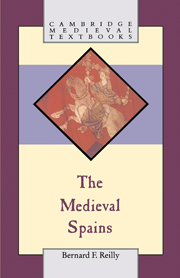Book contents
- Frontmatter
- Contents
- Maps
- 1 At the edge of empire
- 2 The Germanic kingdom in Iberia, 569–711
- 3 Iberia and the dār-al-Islam, 711–1009
- 4 Christian reconquista and African Empire, 1009–1157
- 5 The definition of Iberian autonomy: 1157–1295
- 6 The evolution of the medieval order in Iberia
- 7 The passing of medieval Iberia, 1248–1474
- An introductory bibliography
- Index
- Cambridge Medieval Textbooks
2 - The Germanic kingdom in Iberia, 569–711
Published online by Cambridge University Press: 05 June 2012
- Frontmatter
- Contents
- Maps
- 1 At the edge of empire
- 2 The Germanic kingdom in Iberia, 569–711
- 3 Iberia and the dār-al-Islam, 711–1009
- 4 Christian reconquista and African Empire, 1009–1157
- 5 The definition of Iberian autonomy: 1157–1295
- 6 The evolution of the medieval order in Iberia
- 7 The passing of medieval Iberia, 1248–1474
- An introductory bibliography
- Index
- Cambridge Medieval Textbooks
Summary
With the accession of Leovigild in 569 the Iberian kingdom of the Visigoths was to become the vehicle for the creation of a new society during the next century and a half. In its course the distinction between Roman and German would disappear as conquerors and conquered insensibly became one people. Germanic kingship and the Germanic conception of nobility would gradually replace the institutions and offices of empire and would inaugurate a reign over the western political and social imagination which still has not entirely lost its power. Yet the most profound transformation in process during that 150 years was the Christianization of the Iberian population. That conversion was, of course, intimately related to the emergence of a stable monarchy and a stable nobility as institutions which could survive the eighth-century collapse of the Visigothic realm itself and emerge, phoenix-like, in the new Christian world of Asturias. More significantly still, that newly achieved Christianity would furnish an alternative, a counter-, identity to an Iberian population submerged beneath the tide of Islam. As Mozarabic Christians they would endure. As Asturian Christians they would resist. Finally, after almost 800 years, the Iberian kingdoms would have reclaimed the entire peninsula for a social order which was formally Christian, monarchical, and hierarchical.
The origins of Christianity in Iberia date from the Roman era, of course, and well before the fall of Roman authority in the peninsula there were already a body of Christian martyrs, an organized diocesan structure, and even a fair number of monasteries.
- Type
- Chapter
- Information
- The Medieval Spains , pp. 17 - 50Publisher: Cambridge University PressPrint publication year: 1993



